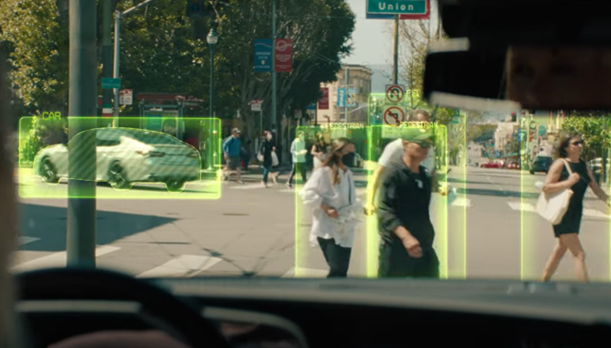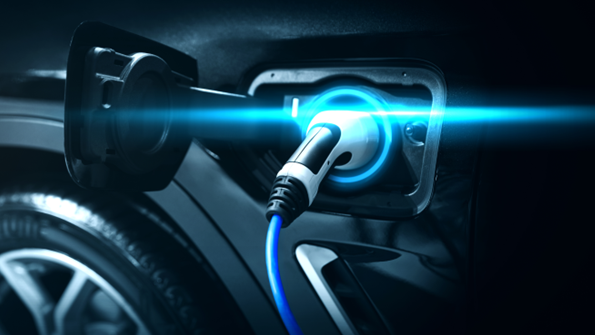What’s the difference between lidar and radar?
Lidar and radar are both 3D sensing technologies using electromagnetic waves. While radar uses radio waves, lidar uses light waves, specifically photons.
The key difference between radar and lidar is clarity in detecting the size and position of objects. In scientific terms, lidar has much higher angular resolution than radar, indicating higher accuracy. This is because radars in today’s cars use millimeter (mm) microwaves, but the most common light wavelengths used in lidars are 905 and 1550 nanometers (nm). One mm equals 1,000,000 nm – think about the difference in finesse!
Lidar excels in object differentiation and precise localization. While radar can detect a potential obstacle on the road ahead of you, it won’t be able to tell you if it’s in your lane, on the shoulder, or in the lane next to you. Radar struggles to differentiate objects when grouped together, but lidar data is accurate enough to precisely determine the number of vehicles, pedestrians or other objects within the group.
Radars are widely deployed in today’s ADAS systems due to mature industrialization. Lidars were seen as expensive devices, but times have changed. At Cepton, we are committed to commercializing lidar for mass-market adoption by achieving the right balance between performance, reliability and cost.

With camera and AI, why is lidar still needed in vehicles?
Whether influenced by Mr. Elon Musk or not, some might think that relying solely on camera-based computer vision is enough for ADAS, or even full autonomy. However, we haven't quite seen camera-based systems reach the level of safety and reliability we all deserve.
AI simply isn’t “street smart” enough to safely chauffeur your car 24/7, especially in poor lighting conditions. Challenges in data quality and quantity, algorithms, and computing power are like those stubborn speed bumps on the road to AI-enabled safe autonomy.
Lidar significantly enhances the data set to generate more accurate results. While determining an object's exact location, speed and size based on camera images requires good lighting, thorough AI training, and high processing capabilities, lidar data inherently provides this information as a 3D sensing technology. If cameras “see” things, lidars “touch” them for you. Elon's stop sign T-shirt can’t confuse a lidar-based ADAS the same way it did Autopilot. Lidar makes it much easier to distinguish actual objects from graphics printed on clothes, buses or billboards, determine the safe distance behind a truck with its tailgate down, or simply tell the difference between a small dog up close or a big dog far away.
Lidar isn’t here to take camera’s job, but to provide smarter and leaner data that make the vehicle’s brain sharper. Just like humans, vehicles need a complete sensory system to navigate the world.

Why is it taking so long for lidar to go into passenger cars?
Because safety remains the top priority for the automotive industry. While some automakers have been aggressively pushing forward with self-driving features, most OEMs we have worked with are focusing on implementing rigorous reliability standards before deploying new ADAS sensors and technologies on the road.
We have worked with multiple global OEMs behind the scenes to enable the safe deployment of ADAS. There have been tremendous efforts on both sides every step of the way. Particularly, rigorous testing and validation are essential to ensure that lidar systems can withstand various environmental conditions and scenarios. Vehicle integration, data fusion, and cybersecurity are also integral components of the process.
More importantly, while it's not difficult to produce one perfect unit, manufacturing lidar sensors in automotive volumes cost-effectively has been a key challenge for the entire industry. That's why we are collaborating with experienced Tier 1 suppliers and manufacturing partners, learning from the industry's best to ramp up volume production.
It's been a long journey, but lidar-equipped consumer vehicles are finally becoming a reality. We can’t wait to be part of your new experience of safe autonomy!

How far does a lidar need to see for ADAS? What about fully autonomous driving?
First of all, range and resolution should be considered together. Without high resolution, a long range does not guarantee sufficient detection capabilities.
While “the longer range, the better” sounds like a no-brainer, we and our OEM customers know this isn’t always the case. For automotive lidars, the drawbacks of too long a range might outweigh its benefits. Every voxel (or lidar pixel) consumes power – and that could be a problem, as we’ll explain in the next section.
Lidar range is primarily dependent on driving speed. Let’s assume your car is traveling at 70mph. Under usual circumstances, its computer system should take no more than 3 to 4 seconds to identify and respond to an obstacle, be it braking or another maneuver. The braking distance ranges from 50 to 100 meters, depending on dry or wet road conditions. This totals to an effective sensing distance of 200m to 250m for obstacle detection, with sufficient padding. Additionally, we expect computing systems to become faster over time.
Does full autonomy require longer range? If fully autonomous vehicles are to drive much faster than our current speed limits, then a longer range is needed. But let’s learn to walk before we run. Autonomous vehicles likely won’t be driving over the speed limit anytime soon. In fact, specifications like field of view coverage would be more crucial than range, along with many other things, for lidars in autonomous vehicles.

Why does power consumption matter for automotive lidar?
All OEMs are looking to reduce the environmental footprint of their vehicles. With limited power resources, integrating power-efficient lidar helps ensure that a vehicle's overall energy consumption remains manageable. In the case of electric vehicles, minimizing lidar power consumption is crucial for extending the vehicle's mileage between charges.
Low power consumption is also a major enabler of seamless integration. High power consumption results in excessive heat, preventing the lidar from being embedded into many common locations. Other problems include compromised sensor performance, premature wear and failure as well as safety risks, just to name a few. If you’ve ever experienced an iPhone shutdown due to overheating, you know what we’re talking about.
Some lidar manufacturers combine high-power consumption sensors with an active cooling system to reduce the temperature. However, this further adds to the energy burden of the entire vehicle, while also taking up more space within the sensor farm.
At Cepton, we chose to get to the root of the problem. Our lidar architecture and proprietary ASIC chipset maximize the system efficiency to enable high performance at unprecedentedly low power consumption. This made it possible to integrate lidars behind the windshield, in the roofline and all around the vehicle without the need for an additional cooling solution.

Why does an automotive lidar need to be as compact as possible?
Because vehicle design matters. You might be surprised to know that a new vehicle design starts with styling, not engineering.
Future cars are only going to get sleeker, and so are their technologies. The best lidars are those so discretely hidden that you don’t even notice their existence. For automotive applications where every inch counts, a compact lidar design enables a wide range of placement options without disrupting a vehicle’s appearance, including behind the windshield, in the roofline, the fascia and the headlamp etc.
With so many integration options, multiple sensors can be seamlessly embedded in a vehicle, creating a lidar “cocoon” that helps prevent accidents through long-range obstacle detection and near-range blind spot elimination. The same concept applies in non-automotive applications, where smaller sensors enable more flexible and efficient integration options.
A smaller size doesn’t equate to compromised performance. An elegant lidar architecture is key to minimizing sensor footprint while enabling long range and high resolution. System on Chip (SoC) is also a key enabler of high efficiency within a small package – elevated signal and image processing capabilities improve sensor performance without optical design changes, such as a larger aperture. Compared to merchant silicon devices, proprietary lidar ASIC chips are much smaller, smarter and more power-efficient.










